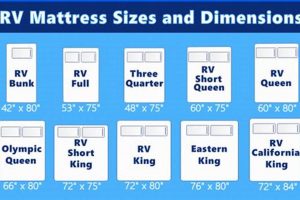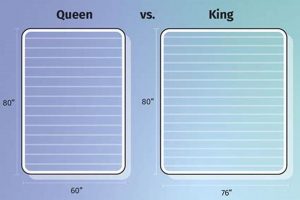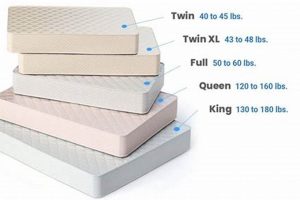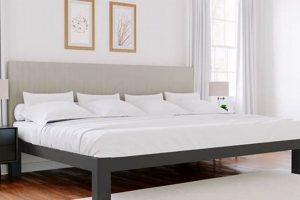A large-format, liquid-filled sleep surface designed to conform to the body, offering a unique sleep experience. These products, intended for compatibility with correspondingly sized bed frames, utilize water displacement to distribute weight evenly. As an illustration, consider the enhanced support and potential pressure relief offered by the even distribution.
The significance of such a design lies in its ability to potentially alleviate pressure points, contributing to a more restful sleep for some individuals. Furthermore, these sleeping surfaces have a notable history, evolving from rudimentary water-filled sacks to more sophisticated, temperature-controlled systems. The benefits often cited include individualized comfort and potential therapeutic advantages for certain physical conditions.
The following sections will delve into the specific construction materials, maintenance considerations, and optimal usage practices associated with this type of sleep system, providing a detailed understanding of its features and long-term ownership considerations. This exploration aims to equip individuals with the necessary information to make informed decisions regarding suitability and implementation within their personal sleep environment.
Essential Considerations for Large Water-Filled Sleep Systems
The following guidelines offer crucial information for the successful utilization and maintenance of substantial liquid-based sleeping surfaces.
Tip 1: Foundation Integrity: Prior to installation, ensure the bed frame is engineered to withstand the significant weight associated with a fully filled water chamber. Reinforce the frame if necessary, as structural failure can result in substantial property damage.
Tip 2: Proper Filling Technique: Adhere strictly to the manufacturer’s instructions regarding the filling process. Overfilling can compromise the mattress integrity, while underfilling can diminish the intended support and comfort.
Tip 3: Water Conditioner Usage: Regularly introduce the recommended water conditioner to inhibit the growth of algae and bacteria within the water chamber. Failure to do so can lead to unpleasant odors and potentially compromise the mattress material.
Tip 4: Temperature Regulation: Maintain consistent temperature control to ensure optimal comfort and prolong the life of the mattress. Excessive heating or cooling can degrade the materials over time.
Tip 5: Leak Detection and Repair: Periodically inspect the mattress for any signs of leakage. Address even minor leaks promptly with appropriate repair kits to prevent extensive water damage.
Tip 6: Secure Fill and Drain Valves: Confirm that fill and drain valves are securely closed after each use to prevent unintentional water release. Damaged valves should be replaced immediately.
Tip 7: Professional Assistance: For complex tasks such as relocation or major repairs, consider engaging qualified professionals experienced in handling large water-filled sleep systems.
Adhering to these guidelines promotes longevity, ensures consistent comfort, and minimizes potential risks associated with water-based sleep technology.
The subsequent sections will elaborate on specific product categories and provide detailed comparative analyses to further inform the consumer’s purchasing decisions.
1. Size and Dimensions
The dimensions of a large water-filled sleep surface directly influence its compatibility with standard bed frames. Inaccurate sizing can result in an unstable and unsupported mattress, potentially leading to premature wear or even structural failure of the frame itself. For instance, a mattress exceeding the specified frame dimensions may cause undue stress on the supporting structure, increasing the risk of collapse. Conversely, a mattress significantly smaller than the frame may shift during use, compromising support and comfort.
Moreover, the dimensions impact the water volume required for optimal performance. An undersized water chamber may not provide adequate support, leading to discomfort and potential back pain. Conversely, an excessively large water chamber, within a specific frame, could exert excessive pressure on the mattress seams and surrounding frame components, potentially causing leaks or structural damage. Maintaining adherence to the manufacturer’s specified fill levels is essential to ensuring proper weight distribution and support.
Therefore, precise adherence to size and dimension specifications is paramount when selecting a water-filled mattress. Careful measurement of the bed frame and thorough review of the mattress’s stated dimensions is a critical step. Failure to properly match sizes can negate the intended benefits of this sleep system, leading to dissatisfaction and potential safety hazards. The practical implications of this understanding are reflected in the longevity of the mattress, the stability of the bed frame, and, ultimately, the quality of sleep experienced.
2. Weight Distribution
A critical attribute of a large, water-filled sleep surface is its ability to distribute weight evenly across its surface. This uniform distribution is a direct consequence of the hydrostatic pressure inherent in liquid systems. When weight is applied to one area, the pressure is transmitted equally throughout the water chamber, minimizing localized pressure points. This contrasts with traditional innerspring or foam mattresses, where pressure tends to concentrate at points of contact. An inadequate or uneven weight distribution can compromise the intended ergonomic benefits and potentially lead to discomfort or even exacerbate existing musculoskeletal issues. For example, if a support baffle within the water chamber fails, the uneven distribution can create a sagging effect, mimicking the pressure point issues of conventional mattresses.
The effectiveness of this weight distribution is also contingent on the mattress’s internal structure. Some designs incorporate fiber baffles or wave reduction systems to control water movement and prevent excessive displacement. These features aim to mitigate the “wave” effect often associated with this technology, ensuring a more stable and supportive sleeping surface. The absence or degradation of these internal components directly impacts the mattress’s ability to evenly distribute weight. A mattress lacking sufficient wave reduction, for instance, can result in significant motion transfer, disrupting the sleep of a bed partner. This further underscores the importance of quality construction and appropriate internal design.
In summation, consistent and even weight distribution is a fundamental design principle of a large format, liquid-based sleep surface. Its efficacy is determined by the integrity of the water chamber, the effectiveness of internal wave reduction systems, and adherence to recommended fill levels.
The practical significance lies in the potential for enhanced comfort, reduced pressure points, and improved sleep quality. However, these benefits are contingent on proper maintenance and ensuring the mattress’s structural integrity to preserve its intended weight distribution characteristics.
3. Temperature Control
The ability to regulate temperature is a significant attribute of large, water-based sleep systems, offering a degree of customization unavailable in traditional mattresses. Water’s high specific heat capacity allows it to absorb and retain heat effectively, creating a thermal mass that can be actively controlled. This attribute is achieved through the integration of a heating element and a thermostat. For example, individuals residing in colder climates may utilize this feature to pre-heat the mattress before sleep, creating a warm and inviting sleeping environment. Conversely, although less common, cooling systems can also be integrated to lower the surface temperature for increased comfort in warmer climates or for individuals who tend to overheat during sleep. The absence of functional temperature regulation compromises the potential for personalized comfort, rendering it similar to a standard mattress in thermal performance.
The effectiveness of the temperature control system hinges on several factors. These include the insulation surrounding the water chamber, the accuracy of the thermostat, and the power output of the heating element. Inefficient insulation can lead to heat loss, requiring the heating element to work harder and potentially increasing energy consumption. Inaccurate thermostats can result in temperature fluctuations, leading to discomfort. Underpowered heating elements may struggle to maintain the desired temperature, especially in colder environments. The proper functioning of each component is essential for maintaining a stable and comfortable sleeping temperature. Furthermore, power consumption represents a recurring operational cost. These features present a challenge for individuals seeking energy-efficient solutions, so it is imperative to consider energy efficiency during selection.
In conclusion, temperature regulation represents a key differentiator of large water-filled sleep systems. It offers a degree of personalized comfort that is simply unachievable with other sleep surface technologies. The benefits, however, are contingent upon the proper functioning of the heating system, adequate insulation, and accurate temperature control. Challenges relating to energy consumption and potential component failure represent significant considerations for prospective users. Therefore, careful evaluation of the system’s energy efficiency, reliability, and maintenance requirements is crucial prior to purchase.
4. Material Durability
Material durability is paramount in the context of a large water-filled sleep system due to the substantial stresses placed upon the mattress. The sheer volume of water contained within exerts constant pressure, particularly on seams and corners. If the materials used are substandard, premature failure, such as leaks or seam separation, is highly probable. For example, a vinyl material with inadequate tensile strength will be prone to stretching and eventual rupture under prolonged hydrostatic pressure. The effects of such a failure extend beyond mere inconvenience, potentially leading to significant water damage to the surrounding environment. Therefore, the selection of robust, high-quality materials is not merely a matter of comfort but a critical factor in preventing catastrophic failure.
The type of material used also influences the mattress’s resistance to degradation from factors such as UV exposure, chemical interactions, and physical abrasion. Vinyl formulations designed for waterbeds often incorporate UV inhibitors to mitigate sun damage and plasticizers to maintain flexibility over time. Absence of these additives can lead to hardening and cracking, significantly reducing the lifespan of the product. Furthermore, the compatibility of the material with water conditioning chemicals is crucial; incompatible materials may degrade, leach chemicals into the water, or promote the growth of undesirable organisms. Instances of such degradation have been documented, resulting in discolored water, unpleasant odors, and compromised mattress integrity.
In summary, the longevity and functionality of a large water-filled sleep surface are inextricably linked to the durability of the materials used in its construction. The high-stress environment necessitates the use of robust, chemically resistant, and UV-stable materials. Failure to prioritize material quality results in a significantly increased risk of leaks, premature degradation, and potential property damage. Prospective purchasers should therefore carefully evaluate material specifications and manufacturer warranties to ensure long-term performance and reliability.
5. Maintenance Needs
The maintenance needs of a large, water-filled sleep system are considerably more demanding than those of conventional mattresses. Neglecting these requirements can lead to a cascade of negative effects, ranging from diminished comfort and shortened lifespan to potential property damage. Specifically, the regular addition of water conditioner is essential to inhibit bacterial and algal growth within the water chamber. Failure to do so results in the accumulation of organic matter, leading to unpleasant odors, discoloration of the water, and potential degradation of the mattress material. For example, the growth of anaerobic bacteria can produce hydrogen sulfide gas, characterized by a distinct “rotten egg” smell, which permeates the surrounding environment and necessitates complete draining and refilling of the mattress.
Beyond water conditioning, periodic inspection for leaks is crucial. The sheer volume of water contained within these systems means that even small leaks can result in significant water damage over time. The constant pressure exerted on seams and valves increases the likelihood of slow leaks, which may go unnoticed until substantial water accumulates. Mitigation strategies include the application of sealant to vulnerable areas and the prompt repair of any detected leaks using appropriate repair kits. Furthermore, maintaining the appropriate water level is essential for optimal support and comfort. Overfilling can place excessive stress on the seams, while underfilling can compromise the mattress’s ability to evenly distribute weight. The temperature control system also requires periodic inspection and maintenance. Heating elements can fail over time, and thermostats can become inaccurate, leading to inconsistent temperature regulation and potential discomfort.
In conclusion, the ongoing maintenance requirements of a large, water-filled sleep system represent a significant commitment. The necessary tasks, including water conditioning, leak detection, water level regulation, and temperature control system maintenance, are essential for preserving the mattress’s performance and preventing potential damage. Addressing these needs proactively is key to maximizing the lifespan of the product and ensuring a comfortable and hygienic sleeping environment. The neglect of these maintenance practices in
variably leads to diminished performance, increased risk of failure, and ultimately, necessitates premature replacement of the sleep system.
6. Support Structure
The support structure is a non-negotiable element within a large water-filled sleep system. It directly dictates the stability, longevity, and safety of the entire setup. The considerable weight exerted by a filled system necessitates a robust framework capable of bearing this load without deformation or failure. Inadequate support leads to uneven weight distribution, compromising comfort and potentially accelerating wear on the mattress itself. A real-life example includes bed frames designed for innerspring mattresses collapsing under the concentrated load of a water-filled alternative, leading to water damage and potential injury. This underscores the practical significance of selecting a frame explicitly engineered for this purpose.
The support structure comprises several interconnected components, including the base, side rails, and internal bracing. The base must provide a solid and level foundation, typically constructed from reinforced wood or metal. Side rails contribute to lateral stability, preventing the mattress from bulging or shifting. Internal bracing distributes the weight across the frame, minimizing stress concentration on any single point. Frames lacking sufficient bracing are prone to warping or cracking under sustained load. The choice of materials and the quality of construction are paramount in determining the frame’s load-bearing capacity. Specifically, frames utilizing lower-grade materials or flimsy construction methods are demonstrably less resistant to the forces exerted by a filled water mattress.
In conclusion, the support structure is an integral and indispensable component of the overall large water-filled sleep system. It serves as the foundation upon which the mattress rests, providing stability, preventing damage, and ensuring long-term functionality. Compromising on the quality or design of the support structure is a false economy, as the potential costs associated with failure far outweigh any initial savings. Therefore, thorough evaluation of the frame’s load-bearing capacity, construction materials, and overall design is critical to ensuring a safe, comfortable, and durable sleep environment.
Frequently Asked Questions
The following addresses common inquiries regarding the acquisition, implementation, and maintenance of substantial liquid-based sleeping surfaces.
Question 1: What is the expected lifespan?
The lifespan varies significantly based on material quality, maintenance practices, and usage patterns. Generally, a well-maintained system can last 10-15 years. However, substandard materials or neglected maintenance can drastically shorten this lifespan.
Question 2: Are these systems prone to leaks?
The potential for leaks is inherent in any liquid-filled system. However, modern designs utilize durable materials and reinforced seams to minimize this risk. Regular inspection and prompt repair of any detected leaks are crucial preventative measures.
Question 3: How much weight can the system add to a room?
The weight is considerable, often exceeding 1,500 pounds when filled. Ensure the flooring and support structure are adequate to bear this load. Consult with a structural engineer if there are any concerns regarding load-bearing capacity.
Question 4: Does motion transfer impact sleep quality?
Motion transfer is a characteristic of these systems. However, wave reduction technologies, such as fiber baffles, mitigate this effect. Selecting a design with robust wave reduction is recommended to minimize partner disturbance.
Question 5: How is the system drained and moved?
Draining requires a specialized pump or siphon system. The process is time-consuming and requires careful adherence to manufacturer instructions. Due to the weight and bulk, professional assistance is advisable for relocation.
Question 6: What are the common issues with the internal heater system?
Heating element failure and thermostat malfunction are the most prevalent issues. Periodic inspection and prompt replacement of faulty components are necessary to maintain consistent temperature regulation.
Proper care and preventative measures are key to maximizing the longevity and performance of this sleep technology.
The subsequent section will present a comparative analysis of various models, highlighting their respective strengths and weaknesses to facilitate informed decision-making.
Conclusion
The preceding analysis has presented a comprehensive overview of the king size waterbed mattress, encompassing its features, benefits, maintenance requirements, and potential challenges. From its unique weight distribution capabilities to the intricacies of temperature regulation and the demands of material durability, each aspect has been examined with the aim of providing a clear understanding of this specialized sleep system.
Ultimately, the decision to adopt this technology requires careful consideration of individual needs, lifestyle factors, and a commitment to ongoing maintenance. Prospective users are encouraged to leverage the information presented to make informed choices, prioritizing long-term value and ensuring compatibility with their specific circumstances. The future viability hinges on continued innovation in materials science and engineering to address existing limitations and enhance the overall user experience. The prospective user should always keep in mind that doing thorough research is essential for a long time of sleep satisfaction.


![Best Walmart King Size Blow Up Mattress [Deals!] Organic & Natural Mattress Buyer’s Guide: Non-Toxic Sleep Solutions Best Walmart King Size Blow Up Mattress [Deals!] | Organic & Natural Mattress Buyer’s Guide: Non-Toxic Sleep Solutions](https://mattressworldpa.com/wp-content/uploads/2025/07/th-8177-300x200.jpg)


![Best Soft King Mattress [Guide] For Restful Sleep Organic & Natural Mattress Buyer’s Guide: Non-Toxic Sleep Solutions Best Soft King Mattress [Guide] For Restful Sleep | Organic & Natural Mattress Buyer’s Guide: Non-Toxic Sleep Solutions](https://mattressworldpa.com/wp-content/uploads/2025/07/th-8174-300x200.jpg)

